浙江高考英语试卷答案及解析.pdf
- 格式:pdf
- 大小:268.50 KB
- 文档页数:12
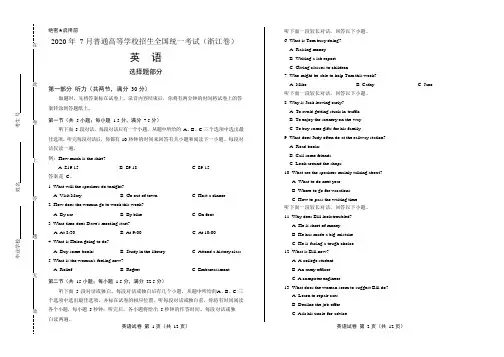
英语试卷 第 1 页(共 12 页)英语试卷 第 2 页(共 12 页)考生号绝密★启用前2020 年 7 月普通高等学校招生全国统一考试(浙江卷)英 语选择题部分第一部分 听力(共两节,满分 30 分)做题时,先将答案标在试卷上。
录音内容结束后,你将有两分钟的时间将试卷上的答案转涂到答题纸上。
第一节(共 5 小题;每小题 1.5 分,满分 7.5 分)听下面 5 段对话。
每段对话后有一个小题,从题中所给的 A 、B 、C 三个选项中选出最佳选项。
听完每段对话后,你都有 10 秒钟的时间来回答有关小题和阅读下一小题。
每段对话仅读一遍。
例:How much is the shirt?A. £19.15.B. £9.18.C. £9.15.答案是 C 。
1. What will the speakers do tonight?A. Visit Mary.B. Go out of town.C. Host a dinner.2. How does the woman go to work this week? A. By car.B. By bike.C. On foot.3. What time does Dave's meeting start?A. At 8:30.B. At 9:00.C. At 10:00.4. What is Helen going to do? A. Buy some books.B. Study in the library.C. Attend a history class.5. What is the woman's feeling now?A. Relief.B. Regret.C. Embarrassment.第二节(共 15 小题;每小题 1.5 分,满分 22.5 分)听下面 5 段对话或独白。
每段对话或独白后有几个小题,从题中所给的A 、B 、C 三个选项中选出最佳选项,并标在试卷的相应位置。
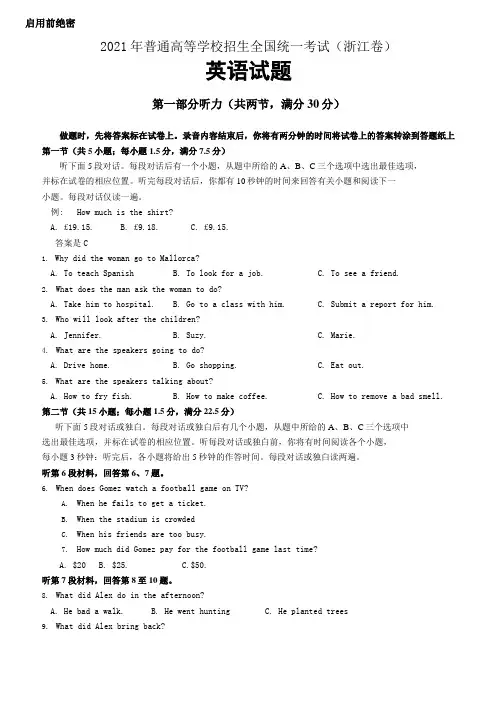
启用前绝密2021年普通高等学校招生全国统一考试(浙江卷)英语试题第一部分听力(共两节,满分30分)做题时,先将答案标在试卷上。
录音内容结束后,你将有两分钟的时间将试卷上的答案转涂到答题纸上第一节(共5小题;每小题1.5分,满分7.5分)听下面5段对话。
每段对话后有一个小题,从题中所给的A、B、C三个选项中选出最佳选项,并标在试卷的相应位置。
听完每段对话后,你都有10秒钟的时间来回答有关小题和阅读下一小题。
每段对话仅读一遍。
例: How much is the shirt?A. £19.15.B. £9.18.C. £9.15.答案是C1.Why did the woman go to Mallorca?A. To teach SpanishB. To look for a job.C. To see a friend.2.What does the man ask the woman to do?A. Take him to hospital.B. Go to a class with him.C. Submit a report for him.3.Who will look after the children?A. Jennifer.B. Suzy.C. Marie.4.What are the speakers going to do?A. Drive home.B. Go shopping.C. Eat out.5.What are the speakers talking about?A. How to fry fish.B. How to make coffee.C. How to remove a bad smell.第二节(共15小题;每小题1.5分,满分22.5分)听下面5段对话或独白。
每段对话或独白后有几个小题,从题中所给的A、B、C三个选项中选出最佳选项,并标在试卷的相应位置。

启用前绝密2021年普通高等学校招生全国统一考试(浙江卷)英语试题第一部分听力(共两节,满分30分)做题时,先将答案标在试卷上。
录音内容结束后,你将有两分钟的时间将试卷上的答案转涂到答题纸上第一节(共5小题;每小题1.5分,满分7.5分)听下面5段对话。
每段对话后有一个小题,从题中所给的A、B、C三个选项中选出最佳选项,并标在试卷的相应位置。
听完每段对话后,你都有10秒钟的时间来回答有关小题和阅读下一小题。
每段对话仅读一遍。
例: How much is the shirt?A. £19.15.B. £9.18.C. £9.15.答案是C1.Why did the woman go to Mallorca?A. To teach SpanishB. To look for a job.C. To see a friend.2.What does the man ask the woman to do?A. Take him to hospital.B. Go to a class with him.C. Submit a report for him.3.Who will look after the children?A. Jennifer.B. Suzy.C. Marie.4.What are the speakers going to do?A. Drive home.B. Go shopping.C. Eat out.5.What are the speakers talking about?A. How to fry fish.B. How to make coffee.C. How to remove a bad smell.第二节(共15小题;每小题1.5分,满分22.5分)听下面5段对话或独白。
每段对话或独白后有几个小题,从题中所给的A、B、C三个选项中选出最佳选项,并标在试卷的相应位置。
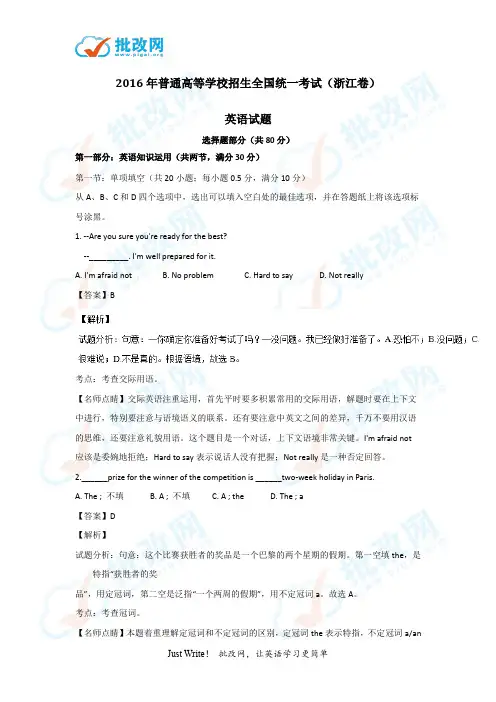
2016年普通高等学校招生全国统一考试(浙江卷)英语试题选择题部分(共80分)第一部分:英语知识运用(共两节,满分30分)第一节:单项填空(共20小题;每小题0.5分,满分10分)从A、B、C和D四个选项中,选出可以填入空白处的最佳选项,并在答题纸上将该选项标号涂黑。
1. --Are you sure you're ready for the best?--_________. I'm well prepared for it.A. I'm afraid notB. No problemC. Hard to sayD. Not really【答案】B考点:考查交际用语。
【名师点睛】交际英语注重运用,首先平时要多积累常用的交际用语,解题时要在上下文中进行,特别要注意与语境语义的联系。
还有要注意中英文之间的差异,千万不要用汉语的思维,还要注意礼貌用语。
这个题目是一个对话,上下文语境非常关键。
I'm afraid not应该是委婉地拒绝;Hard to say表示说话人没有把握;Not really是一种否定回答。
2.______prize for the winner of the competition is ______two-week holiday in Paris.A. The ; 不填B. A ; 不填C. A ; theD. The ; a【答案】D【解析】试题分析:句意:这个比赛获胜者的奖品是一个巴黎的两个星期的假期。
第一空填the,是特指“获胜者的奖品”,用定冠词,第二空是泛指“一个两周的假期”,用不定冠词a。
故选A。
考点:考查冠词。
【名师点睛】本题着重理解定冠词和不定冠词的区别,定冠词the表示特指,不定冠词a/an表示泛指;对于冠词特指和泛指的考查是历年来高考的必考点,平时的学习要多进行积累,仔细分析特指还是泛指。
同时,更为重要的是要多去积累习惯表达,特殊表达,这也是近几年高考习惯考的地方。
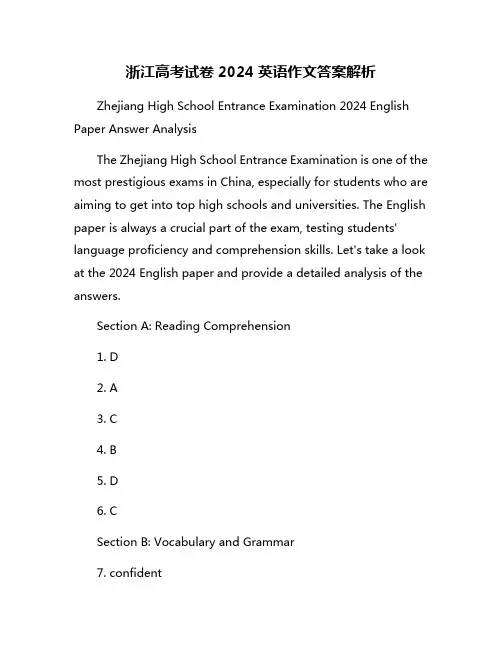
浙江高考试卷2024英语作文答案解析Zhejiang High School Entrance Examination 2024 English Paper Answer AnalysisThe Zhejiang High School Entrance Examination is one of the most prestigious exams in China, especially for students who are aiming to get into top high schools and universities. The English paper is always a crucial part of the exam, testing students' language proficiency and comprehension skills. Let's take a look at the 2024 English paper and provide a detailed analysis of the answers.Section A: Reading Comprehension1. D2. A3. C4. B5. D6. CSection B: Vocabulary and Grammar7. confident8. affordable9. injured10. responsibility11. patience12. furthermore13. in addition14. despite15. whereasSection C: WritingQuestion 1: Write an article about the importance of environmental protection.Answer: Environmental protection is a critical issue that affects us all. It is our responsibility to take care of our planet and ensure that future generations can enjoy a clean and healthy environment. By reducing our carbon footprint, recycling, and preserving natural habitats, we can make a difference in the fight against climate change.Question 2: Write a letter to your friend inviting him/her to visit your hometown.Answer: Dear [Friend's Name],I hope this letter finds you well. I would like to invite you to visit my hometown, which is a beautiful and vibrant city with a rich cultural heritage. There are many attractions to see, delicious local cuisine to try, and friendly people to meet. I am sure you will enjoy your stay and create lasting memories. I look forward to showing you around and spending time together.Best regards,[Your Name]In conclusion, the 2024 Zhejiang High School Entrance Examination English paper was challenging yet comprehensive, testing students' knowledge and skills in reading, vocabulary, grammar, and writing. By analyzing the answers, students can learn from their mistakes and improve their performance in future exams. Good luck to all the test-takers!。
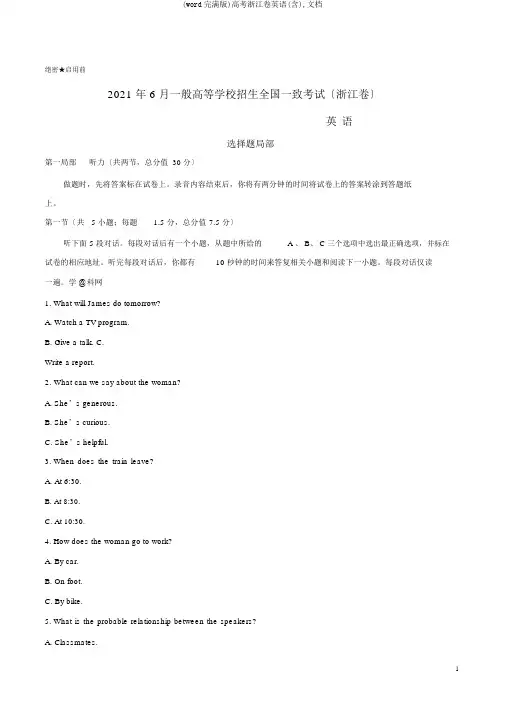
绝密★启用前2021 年 6 月一般高等学校招生全国一致考试〔浙江卷〕英语选择题局部第一局部听力〔共两节,总分值30 分〕做题时,先将答案标在试卷上。
录音内容结束后,你将有两分钟的时间将试卷上的答案转涂到答题纸上。
第一节〔共 5 小题;每题 1.5 分,总分值7.5 分〕听下面 5 段对话。
每段对话后有一个小题,从题中所给的 A 、 B、 C 三个选项中选出最正确选项,并标在试卷的相应地址。
听完每段对话后,你都有10 秒钟的时间来答复相关小题和阅读下一小题。
每段对话仅读一遍。
学 @科网1.What will James do tomorrow?A. Watch a TV program.B. Give a talk.C.Write a report.2.What can we say about the woman?A.She’s generous.B.She’s curious.C.She’s helpful.3.When does the train leave?A. At 6:30.B. At 8:30.C. At 10:30.4.How does the woman go to work?A. By car.B. On foot.C. By bike.5.What is the probable relationship between the speakers?A. Classmates.B. Teacher and student.C. Doctor and patient.第二节〔共15 小题;每题 1.5 分,总分值22.5 分〕听下面 5 段对话或独白。
每段对话或独白后有几个小题,从题中所给的 A 、B 、C 三个选项中选出最正确选项,并标在试卷的相应地址。
听每段对话或独白前,你将有时间阅读各个小题,每题5秒钟;听完后,各小题将给出 5 秒钟的作答时间。
每段对话或独白读两遍。
听第 6 段资料,答复第6、 7 题。
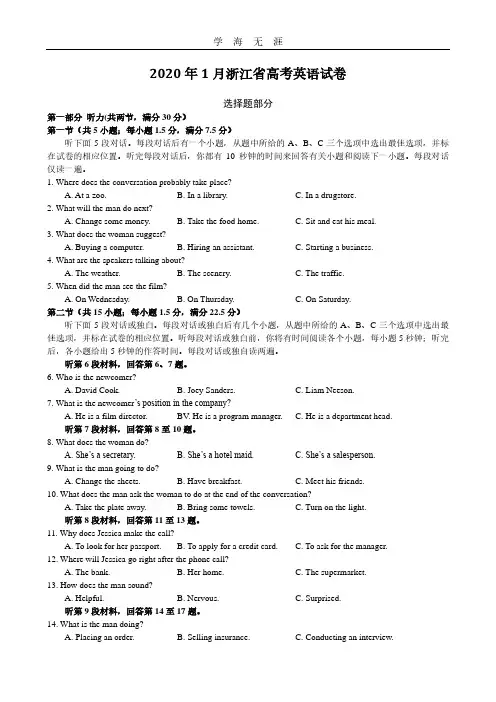
2020年1月浙江省高考英语试卷选择题部分第一部分听力(共两节,满分30分)第一节(共5小题;每小题1.5分,满分7.5分)听下面5段对话。
每段对话后有一个小题,从题中所给的A、B、C三个选项中选出最佳选项,并标在试卷的相应位置。
听完每段对话后,你都有10秒钟的时间来回答有关小题和阅读下一小题。
每段对话仅读一遍。
1. Where does the conversation probably take place?A. At a zoo.B. In a library.C. In a drugstore.2. What will the man do next?A. Change some money.B. Take the food home.C. Sit and eat his meal.3. What does the woman suggest?A. Buying a computer.B. Hiring an assistant.C. Starting a business.4. What are the speakers talking about?A. The weather.B. The scenery.C. The traffic.5. When did the man see the film?A. On Wednesday.B. On Thursday.C. On Saturday.第二节(共15小题;每小题1.5分,满分22.5分)听下面5段对话或独白。
每段对话或独白后有几个小题,从题中所给的A、B、C三个选项中选出最佳选项,并标在试卷的相应位置。
听每段对话或独白前,你将有时间阅读各个小题,每小题5秒钟;听完后,各小题给出5秒钟的作答时间。
每段对话或独自读两遍。
听第6段材料,回答第6、7题。
6. Who is the newcomer?A. David Cook.B. Joey Sanders.C. Liam Neeson.7. What is the newcomer’s position in the company?A. He is a film director. BV. He is a program manager. C. He is a department head.听第7段材料,回答第8至10题。
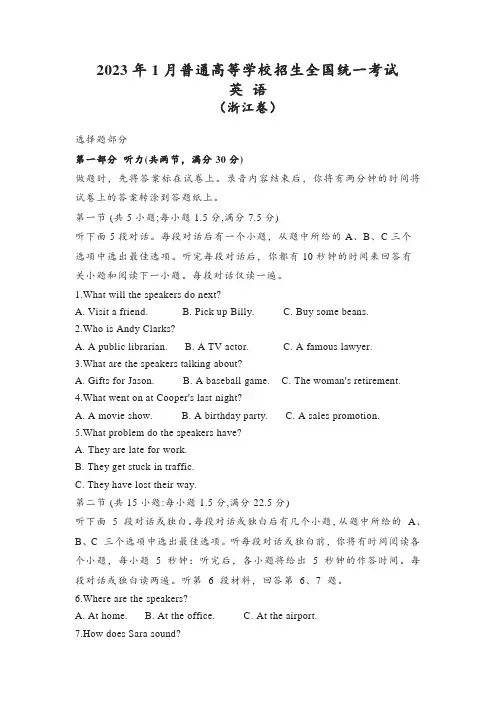
2023年1月普通高等学校招生全国统一考试英语(浙江卷)选择题部分第一部分听力(共两节,满分 30 分)做题时,先将答案标在试卷上。
录音内容结束后,你将有两分钟的时间将试卷上的答案转涂到答题纸上。
第一节 (共 5 小题;每小题 1.5 分,满分 7.5 分)听下面 5 段对话。
每段对话后有一个小题,从题中所给的 A、B、C 三个选项中选出最佳选项。
听完每段对话后,你都有 10 秒钟的时间来回答有关小题和阅读下一小题。
每段对话仅读一遍。
1.What will the speakers do next?A. Visit a friend.B. Pick up Billy.C. Buy some beans.2.Who is Andy Clarks?A. A public librarian.B. A TV actor.C. A famous lawyer.3.What are the speakers talking about?A. Gifts for Jason.B. A baseball game.C. The woman's retirement.4.What went on at Cooper's last night?A. A movie show.B. A birthday party.C. A sales promotion.5.What problem do the speakers have?A. They are late for work.B. They get stuck in traffic.C. They have lost their way.第二节 (共 15 小题:每小题 1.5 分,满分 22.5 分)听下面 5 段对话或独白。
每段对话或独白后有几个小题,从题中所给的A、B、C 三个选项中选出最佳选项。
听每段对话或独白前,你将有时间阅读各个小题,每小题 5 秒钟:听完后,各小题将给出 5 秒钟的作答时间。
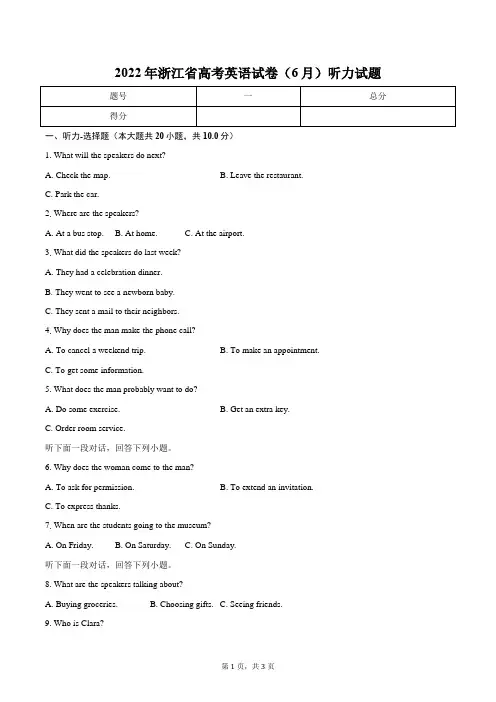
2022年浙江省高考英语试卷(6月)听力试题一、听力-选择题(本大题共20小题,共10.0分)1.What will the speakers do next?A. Check the map.B. Leave the restaurant.C. Park the car.2.Where are the speakers?A. At a bus stop.B. At home.C. At the airport.3.What did the speakers do last week?A. They had a celebration dinner.B. They went to see a newborn baby.C. They sent a mail to their neighbors.4.Why does the man make the phone call?A. To cancel a weekend trip.B. To make an appointment.C. To get some information.5.What does the man probably want to do?A. Do some exercise.B. Get an extra key.C. Order room service.听下面一段对话,回答下列小题。
6.Why does the woman come to the man?A. To ask for permission.B. To extend an invitation.C. To express thanks.7.When are the students going to the museum?A. On Friday.B. On Saturday.C. On Sunday.听下面一段对话,回答下列小题。
8.What are the speakers talking about?A. Buying groceries.B. Choosing gifts.C. Seeing friends.9.Who is Clara?A. The man's wife.B. The man's sister.C. The man's daughter.10.How much did the man spend on the city passes?A. $36.B. $50.C. $150.听下面一段对话,回答下列小题。
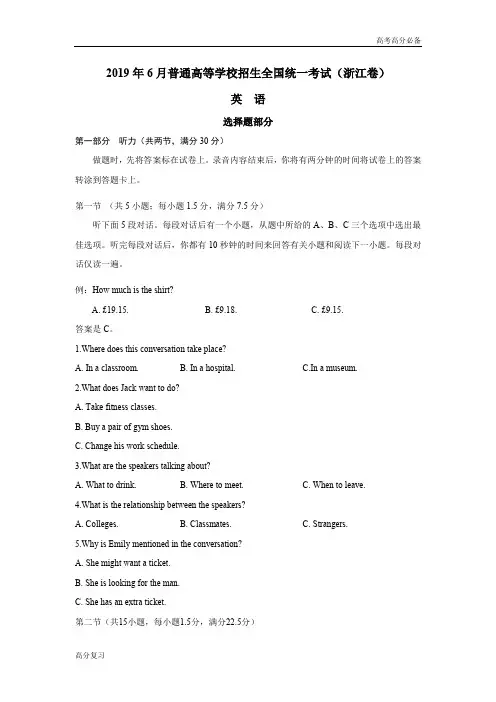
2019年6月普通高等学校招生全国统一考试(浙江卷)英语选择题部分第一部分听力(共两节,满分30分)做题时,先将答案标在试卷上。
录音内容结束后,你将有两分钟的时间将试卷上的答案转涂到答题卡上。
第一节(共5小题;每小题1.5分,满分7.5分)听下面5段对话。
每段对话后有一个小题,从题中所给的A、B、C三个选项中选出最佳选项。
听完每段对话后,你都有10秒钟的时间来回答有关小题和阅读下一小题。
每段对话仅读一遍。
例:How much is the shirt?A. £19.15.B. £9.18.C. £9.15.答案是C。
1.Where does this conversation take place?A. In a classroom.B. In a hospital.C.In a museum.2.What does Jack want to do?A. Take fitness classes.B. Buy a pair of gym shoes.C. Change his work schedule.3.What are the speakers talking about?A. What to drink.B. Where to meet.C. When to leave.4.What is the relationship between the speakers?A. Colleges.B. Classmates.C. Strangers.5.Why is Emily mentioned in the conversation?A. She might want a ticket.B. She is looking for the man.C. She has an extra ticket.第二节(共15小题,每小题1.5分,满分22.5分)听下面5段对话或独白。
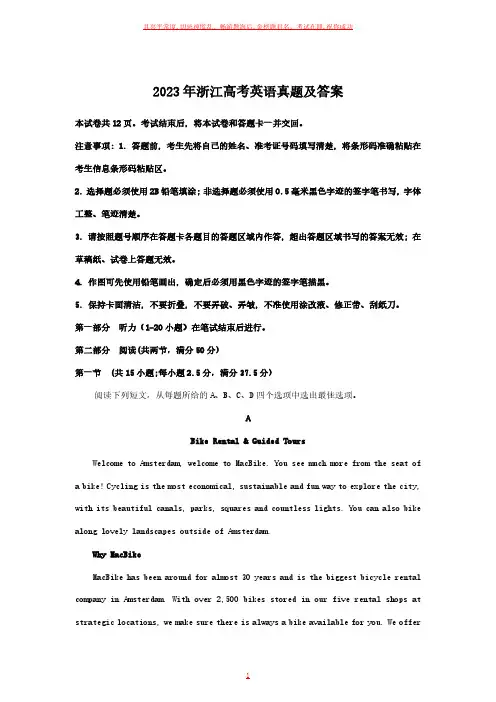
2023年浙江高考英语真题及答案本试卷共12页。
考试结束后, 将本试卷和答题卡一并交回。
注意事项: 1. 答题前, 考生先将自己的姓名、准考证号码填写清楚, 将条形码准确粘贴在考生信息条形码粘贴区。
2. 选择题必须使用2B铅笔填涂; 非选择题必须使用0.5毫米黑色字迹的签字笔书写, 字体工整、笔迹清楚。
3. 请按照题号顺序在答题卡各题目的答题区域内作答, 超出答题区域书写的答案无效; 在草稿纸、试卷上答题无效。
4. 作图可先使用铅笔画出, 确定后必须用黑色字迹的签字笔描黑。
5. 保持卡面清洁, 不要折叠, 不要弄破、弄皱, 不准使用涂改液、修正带、刮纸刀。
第一部分听力(1-20小题)在笔试结束后进行。
第二部分阅读(共两节,满分50分)第一节 (共15小题;每小题2.5分,满分37.5分)阅读下列短文,从每题所给的A、B、C、D四个选项中选出最佳选项。
ABike Rental & Guided ToursWelcome to Amsterdam, welcome to MacBike. You see much more from the seat of a bike! Cycling is the most economical, sustainable and fun way to explore the city, with its beautiful canals, parks, squares and countless lights. You can also bike along lovely landscapes outside of Amsterdam.Why MacBikeMacBike has been around for almost 30 years and is the biggest bicycle rental company in Amsterdam. With over 2,500 bikes stored in our five rental shops at strategic locations, we make sure there is always a bike available for you. We offerthe newest bicycles in a wide variety, including basic bikes with foot brake (刹车), bikes with hand brake and gears (排挡), bikes with child seats, and children’s bikes.PricesHand Brake, Three Gears Foot Brake, No Gears1 hour €7.50 €5.003 hours €11.00 €7.501 day (24 hours) €14.75 €9.75Each additional day €8.00 €6.00Guided City ToursThe 2.5-hour tour covers the Gooyer Windmill, the Skinny Bridge, the Rijksmuseum, Heineken Brewery and much more. The tour departs from Dam Square every hour on the hour, starting at 1:00 pm every day. You can buy your ticket in a MacBike shop or book online.1. What is an advantage of MacBike?A. It gives children a discount.B. It of offers many types of bikes.C. It organizes free cycle tours.D. It has over 2,500 rental shops.2. How much do you pay for renting a bike with hand brake and three gears for two days?A. €15.75.B. €19.50.C. €22.75.D.€29.50.3. Where does the guided city tour start?A. The Gooyer, Windmill.B. The Skinny Bridge.C. Heineken Brewery.D. Dam Square.BWhen John Todd was a child, he loved to explore the woods around his house, observing how nature solved problems. A dirty stream, for example, often became clear after flowing through plants and along rocks where tiny creatures lived. When he got older, John started to wonder if this process could be used to clean up the messes people were making.After studying agriculture, medicine, and fisheries in college, John went back to observing nature and asking questions. Why can certain plants trap harmful bacteria (细菌)? Which kinds of fish can eat cancer-causing chemicals? With the right combination of animals and plants, he figured, maybe he could clean up waste the way nature did. He decided to build what he would later call an eco-machine.The task John set for himself was to remove harmful substances from some sludge (污泥). First, he constructed a series of clear fiberglass tanks connected to each other. Then he went around to local ponds and streams and brought back some plants and animals. He placed them in the tanks and waited. Little by little, these different kinds of life got used to one another and formed their own ecosystem. After a few weeks, John added the sludge.He was amazed at the results. The plants and animals in the eco-machine tookit had all been digested, and the sludge as food and began to eat it! Within weeks,all that was left was pure water.Over the years, John has taken on many big jobs. He developed a greenhouse — like facility that treated sewage (污水) from 1,600 homes in South Burlington. He also designed an eco-machine to clean canal water in Fuzhou, a city in southeast China.“Ecological design” is the name John gives to what he does. “Life on Earth is kind of a box of spare parts for the inventor,” he says. “You put organisms in new relationships and observe what’s happening. Then you let these new systems develop their own ways to self-repair.”4. What can we learn about John from the first two paragraphs?A. He was fond of traveling.B. He enjoyed being alone.C. He had an inquiring mind.D. He longed to be a doctor.5. Why did John put the sludge into the tanks?A. To feed the animals.B. To build an ecosystem.C. To protect the plants.D. To test the eco-machine.6. What is the author’s purpose in mentioning Fuzhou?A. To review John’s research plans.B. To show an application of John’s idea.C. To compare John’s different jobs.D. To erase doubts about John’s invention.7. What is the basis for John’s work?A. Nature can repair itself.B. Organisms need water to survive.C. Life on Earth is diverse.D. Most tiny creatures live in groups.CThe goal of this book is to make the case for digital minimalism, including a detailed exploration of what it asks and why it works, and then to teach you how to adopt this philosophy if you decide it’s right for you.To do so, I divided the book into two parts. In part one, I describe the philosophical foundations of digital minimalism, starting with an examination of the forces that are making so many people’s digital lives increasingly intolerable,before moving on to a detailed discussion of the digital minimalism philosophy.Part one concludes by introducing my suggested method for adopting this philosophy: the digital declutter. This process requires you to step away from optional online activities for thirty days. At the end of the thirty days, you will then add back a small number of carefully chosen online activities that you believe will provide massive benefits to the things you value.In the final chapter of part one, I’ll guide you through carrying out your own digital declutter. In doing so, I’ll draw on an experiment I ran in 2018 in which over 1,600 people agreed to perform a digital declutter. You’ll hear these participants’ stories and learn what strategies worked well for them, and what traps they encountered that you should avoid.The second part of this book takes a closer look at some ideas that will help you cultivate (培养) a sustainable digital minimalism lifestyle. In these chapters, I examine issues such as the importance of solitude (独处) and the necessity of cultivating high-quality leisure to replace the time most now spend on mindless device use. Each chapter concludes with a collection of practices, which are designed to help you act on the big ideas of the chapter. You can view these practices as a toolbox meant to aid your efforts to build a minimalist lifestyle that words for your particular circumstances.8. What is the book aimed at?A. Teaching critical thinking skills.B. Advocating a simple digital lifestyle.C. Solving philosophical problems.D. Promoting the use of a digital device.9. What does the underlined word “declutter” in paragraph 3 mean?A. Clear-up.B. Add-on.C. Check-in.D. Take-over.10. What is presented in the final chapter of part one?A. Theoretical models.B. Statistical methods.C. Practical examples.D. Historical analyses.11. What does the author suggest readers do with the practices offered in part two?A. Use them as needed.B. Recommend them to friends.C. Evaluate their effects.D. Identify the ideas behind them.DOn March 7, 1907, the English statistician Francis Galton published a paper which illustrated what has come to be known as the “wisdom of crowds” effect. The experiment of estimation he conducted showed that in some cases, the average of a large number of independent estimates could be quite accurate.This effect capitalizes on the fact that when people make errors, those errors aren’t always the same. Some people will tend to overestimate, and some to underestimate. When enough of these errors are averaged together, they cancel each other out, resulting in a more accurate estimate. If people are similar and tend to make the same errors, then their errors won’t cancel each other out. In more technical terms, the wisdom of crowds requires that people’s estimates be independent. If for whatever reasons, people’s errors become correlated or dependent, the accuracy of the estimate will go down.But a new study led by Joaquin Navajas offered an interesting twist (转折) on this classic phenomenon. The key finding of the study was that when crowds were further divided into smaller groups that were allowed to have a discussion, the averages from these groups were more accurate than those from an equal number of independent individuals. For instance, the average obtained from the estimates of four discussion groups of five was significantly more accurate than the averageobtained from 20 independent individuals.In a follow-up study with 100 university students, the researchers tried to get a better sense of what the group members actually did in their discussion. Did they tend to go with those most confident about their estimates? Did they follow those least willing to change their minds? This happened some of the time, but it wasn’t the dominant response. Most frequently, the groups reported that they “shared arguments and reasoned together.” Somehow, these arguments and reasoning resulted in a global reduction in error. Although the studies led by Navajas have limitations and many questions remain the potential implications for group discussion and decision-making are enormous.12. What is paragraph 2 of the text mainly about?A. The methods of estimation.B. The underlying logic of the effect.C. The causes of people’s errors.D. The design of Galton’s experiment.13. Navajas’ study found that the average accuracy could increase even if ________.A. the crowds were relatively smallB. there were occasional underestimatesC. individuals did not communicateD. estimates were not fully independent14. What did the follow-up study focus on?A. The size of the groups.B. The dominant members.C. The discussion process.D. The individual estimates.15. What is the author’s attitude toward Navajas’ studies?A. Unclear.B. Dismissive.C. Doubtful.D. Approving.第二节 (共5小题;每小题2.5分,满分12.5分)阅读下面短文,从短文后的选项中选出可以填入空白处的最佳选项。
2023年浙江省高考英语真题及答案解析本试卷共12页。
考试结束后, 将本试卷和答题卡一并交回。
注意事项: 1. 答题前, 考生先将自己的姓名、准考证号码填写清楚, 将条形码准确粘贴在考生信息条形码粘贴区。
2. 选择题必须使用2B铅笔填涂; 非选择题必须使用0.5毫米黑色字迹的签字笔书写, 字体工整、笔迹清楚。
3. 请按照题号顺序在答题卡各题目的答题区域内作答, 超出答题区域书写的答案无效; 在草稿纸、试卷上答题无效。
4. 作图可先使用铅笔画出, 确定后必须用黑色字迹的签字笔描黑。
5. 保持卡面清洁, 不要折叠, 不要弄破、弄皱, 不准使用涂改液、修正带、刮纸刀。
第一部分听力(1-20小题)在笔试结束后进行。
第二部分阅读(共两节,满分50分)第一节(共15小题;每小题2.5分,满分37.5分)阅读下列短文,从每题所给的A、B、C、D四个选项中选出最佳选项。
ABike Rental & Guided ToursWelcome to Amsterdam, welcome to MacBike. You see much more from the seat of a bike! Cycling is the most economical, sustainable and fun way to explore the city, with its beautiful canals, parks, squares and countless lights. You can also bike along lovely landscapes outside of Amsterdam.Why MacBikeMacBike has been around for almost 30 years and is the biggest bicycle rental company in Amsterdam. With over 2,500 bikes stored in our five rental shops at strategic locations, we make sure there is always a bike available for you. We offer the newest bicycles in a wide variety, including basic bikes with foot brake (刹车), bikes with hand brake and gears (排挡), bikes with child seats, and children’s bikes.PricesGuided City ToursThe 2.5-hour tour covers the Gooyer Windmill, the Skinny Bridge, the Rijksmuseum, Heineken Brewery and much more. The tour departs from Dam Square every hour on the hour, starting at 1:00 pm every day. You can buy your ticket in a MacBike shop or book online.1. What is an advantage of MacBike?A. It gives children a discount.B. It of offers many types of bikes.C. It organizes free cycle tours.D. It has over 2,500 rental shops.2. How much do you pay for renting a bike with hand brake and three gears for two days?A. €15.75.B. €19.50.C. €22.75.D. €29.50.3. Where does the guided city tour start?A. The Gooyer, Windmill.B. The Skinny Bridge.C. Heineken Brewery.D. Dam Square.BWhen John Todd was a child, he loved to explore the woods around his house, observing how nature solved problems. A dirty stream, for example, often became clear after flowing through plants and along rocks where tiny creatures lived. When he got older, John started to wonder if this process could be used to clean up the messes people were making.After studying agriculture, medicine, and fisheries in college, John went back to observing nature and asking questions. Why can certain plants trap harmful bacteria (细菌)? Which kinds of fish can eat cancer-causing chemicals? With the right combination of animals and plants, he figured, maybe he could clean up waste the way nature did. He decided to build what he would later call an eco-machine.The task John set for himself was to remove harmful substances from some sludge (污泥). First, he constructed a series of clear fiberglass tanks connected to each other. Then he went around to local ponds and streams and brought back some plants and animals. He placed them in the tanks and waited. Little by little, these different kinds of life got used to one another and formed their own ecosystem. After a few weeks, John added the sludge.He was amazed at the results. The plants and animals in the eco-machine took the sludge as food and began to eat it! Within weeks it had all been digested, and all that was left was pure water.Over the years, John has taken on many big jobs. He developed a greenhouse — like facility that treated sewage (污水) from 1,600 homes in South Burlington. He also designed an eco-machine to clean canal water in Fuzhou, a city in southeast China.“Ecological design” is the name John gives to what he does. “Life on Earth is kind of a box of spare parts for the inventor,” he says. “You put organisms in new relationships and observe what’s happening. Then you let these new systems develop their own ways to self-repair.”4. What can we learn about John from the first two paragraphs?A. He was fond of traveling.B. He enjoyed being alone.C. He had an inquiring mind.D. He longed to be a doctor.5. Why did John put the sludge into the tanks?A. To feed the animals.B. To build an ecosystem.C. To protect the plants.D. To test the eco-machine.6. What is the author’s purpose in mentioning Fuzhou?A. To review John’s research plans.B. To show an ap plication of John’s idea.C. To compare John’s different jobs.D. To erase doubts about John’s invention.7. What is the basis for John’s work?A. Nature can repair itself.B. Organisms need water to survive.C. Life on Earth is diverse.D. Most tiny creatures live in groups.CThe goal of this book is to make the case for digital minimalism, including a detailed exploration of what it asks and why it works, and then to teach you how to adopt this philosophy if you decide it’s right for you.To do so, I divided the book into two parts. In part one, I describe the philosophical foundations of digital minimalism, starting with an examination of the forces that are making so many people’s digital lives increasingly intolerable, before moving on to a detailed discussion of the digital minimalism philosophy.Part one concludes by introducing my suggested method for adopting this philosophy: the digital declutter. This process requires you to step away from optional online activities for thirty days. At the end of the thirty days, you will then add back a small number of carefully chosen online activities that you believe will provide massive benefits to the things you value.In the final chapter of part one, I’ll guide you through carrying out your own digital decl utter. In doing so, I’ll draw on an experiment I ran in 2018 in which over 1,600 people agreed to perform a digital declutter. You’ll hear these participants’ stories and learn what strategies worked well for them, and what traps they encountered that you should avoid.The second part of this book takes a closer look at some ideas that will help you cultivate (培养) a sustainable digital minimalism lifestyle. In these chapters, I examine issues such as the importance of solitude (独处) and the necessity of cultivating high-quality leisure to replace the time most now spend on mindless device use. Each chapter concludes with a collection of practices, which are designed to help you act on the big ideas of the chapter. You can view these practices as a toolbox meant to aid your efforts to build a minimalist lifestyle that words for your particular circumstances.8. What is the book aimed at?A. Teaching critical thinking skills.B. Advocating a simple digital lifestyle.C. Solving philosophical problems.D. Promoting the use of a digital device.9. What does the underlined word “declutter” in paragraph 3 mean?A. Clear-up.B. Add-on.C. Check-in.D.Take-over.10. What is presented in the final chapter of part one?A. Theoretical models.B. Statistical methods.C. Practical examples.D. Historical analyses.11. What does the author suggest readers do with the practices offered in part two?A. Use them as needed.B. Recommend them to friends.C. Evaluate their effects.D. Identify the ideas behind them.DOn March 7, 1907, the English statistician Francis Galton published a paper which illustrated what has come to be known as the “wisdom of crowds” effect. The experiment of estimation he conducted showed that in some cases, the average of a large number of independent estimates could be quite accurate.This effect capitalizes on the fact that when people make errors, those errors aren’t always the same. Some people will tend to overestimate, and some to underestimate. When enough of these errors are averaged together, they cancel each other out, resulting in a more accurate estimate. If people are similar and tend to make the same errors, then their errors won’t cancel each other out. In more technical terms, the wisdom of crowds requires that people’s estimates be indep endent. If for whatever reasons, people’s errors become correlated or dependent, the accuracy of the estimate will go down.But a new study led by Joaquin Navajas offered an interesting twist (转折) on this classic phenomenon. The key finding of the study was that when crowds were further divided into smaller groups that were allowed to have a discussion, the averages from these groups were more accurate than those from an equal number of independent individuals. For instance, the average obtained from the estimates of four discussion groups of five was significantly more accurate than the average obtained from 20 independent individuals.In a follow-up study with 100 university students, the researchers tried to get a better sense of what the group members actually did in their discussion. Did they tend to go with those most confident about their estimates? Did they follow those least willing to change their minds? This happened some of the time, but it wasn’t the dominant response. Most frequently, the groups reported that they “shared arguments and reasoned together.” Somehow, these arguments and reasoning resulted in a global reduction in error. Although the studies led by Navajas have limitations and many questions remain the potential implications for group discussion and decision-making are enormous.12. What is paragraph 2 of the text mainly about?A. The methods of estimation.B. The underlying logic of the effect.C. The causes of people’s errors.D. The design of Galton’s experiment.13. Navajas’ study found that the average accuracy could increase even if ________.A. the crowds were relatively smallB. there were occasional underestimatesC. individuals did not communicateD. estimates were not fully independent14. What did the follow-up study focus on?A. The size of the groups.B. The dominant members.C. The discussion process.D. The individual estimates.15. What is the author’s attitude toward Navajas’ studies?A. Unclear.B. Dismissive.C. Doubtful.D. Approving.第二节(共5小题;每小题2.5分,满分12.5分)阅读下面短文,从短文后的选项中选出可以填入空白处的最佳选项。
学 海 无 涯 2020年1月浙江高考英语试卷(含答案) 第一部分 听力(共两节,满分30分) 做题时,先将答案标在试卷上。录音内容结束后,你将有两分钟的时间将试卷上的答案转涂到答题纸上。 第一节(共5小题;每小题1.5分,满分7.5分) 听下面5段对话。每段对话后有一个小题,从题中所给的A、B、C三个选项中选出最佳选项,并标在试卷的相应位置。听完每段对话后,你都有10秒钟的时间来回答有关小题和阅读下一小题。每段对话仅读一遍。 例:How much is the shirt? A. £19.15. B. £9.18. C. £9.15. 答案是C。 1. Where does the conversation probably take place? A. At a zoo. B. In a library. C. In a drugstore. 2. What will the man do next? A. Change some money. B.Take the food home. C. Sit and eat his meal. 3. What does the woman suggest? A. Buying a computer. B. Hiring an assistant. C. Starting a business. 4. What are the speakers talking about? A. The weather. B. The scenery. C. The traffic. 5. When did the man see the film? A. On Wednesday. B. On Thursday. C. On Saturday. 笫二节(共15小题;每小题1.5分,满分22.5分) 听下面5段对话或独内。每段对话或独白后有几个小题,从题中所给的A、B、C三个选项中选出最佳选项,并标在试卷的相应位置。听每段对话或独内前,你将有时间阅读各个小题,每小题5秒钟;听完后,各小题将给出5秒钟的作答时间。每段对话或独内读两遍。 听第6段材料,回答笫6、7题。 6. Who is the newcomer? A. David Cook. B. Joey Sanders. C. Liam Neeson. 7. What is the newcomer’s position in the company? A. He is a film director. B. He is a program manager. C. He is a department head. 听第7段材料,回答笫8至10题。 8. What does the woman do? A. She’s a secretary. B. She’s a hotel maid. C. She’s a salesperson. 9. What is the man going to do? A. Change the sheets. B. Have breakfast. C. Meet his friends. 10. What does the man ask the woman to do at the end of the conversation? A. Take the plate away. B. Bring some towels. C. Turn on the light. 听第8段材料,回答笫11至13题。 11. Why does Jessica make the call? A. To look for her passport. B. To apply for a credit card. 学 海 无 涯 C. To ask for the manager. 12. Where will Jessica go right after the phone call? A. The bank. B. Her home. C. The supermarket. 13. How does the man sound? A. Helpful. B. Nervous. C. Surprised. 听第9段材料,回答第14至17题。 14. What is the man doing? A. Placing an order. B. Selling insurance. C. Conducting an interview. 15. What did Leaney study for a degree? A. Finance. B. Education. C. Public Relations. 16. What is an advantage of a smaller business according to Leaney? A. Greater contributions to the neighborhood. B. Closer employer-employee relationship. C. More flexibility in providing services. 17. What is Leaney’s plan for the next two weeks? A.To visit her parents. B. To call her relatives. C. To finish her work. 听第10段材料,回答第18至20题。 18. What is the purpose of the talk? A.To present a prize. B. To introduce a lecturer. C. To recommend a book. 19. Where is Russel working now? A. In Oxford. B. In Chicago. C. In Virginia. 20. What does Russel think of sleep? A. It’s seldom studied. B. It’s just a waste of time. C. It’s of great importance. 第二部分 阅读理解(共两节,满分35分) 第一节(共10小题;每小题2.5分,满分25分) 阅读下列短文,从每题所给的A、B、C和D四个选项中,选出最佳选项,并在答题纸上将该项涂黑。 A I never knew anyone who’d grown up in Jackson without being afraid of Mrs. Calloway, our librarian. She ran Jackson’s Carnegie Library absolutely by herself. SILENCE in big black letters was on signs hung everywhere. If she thought you were dressed improperly, she sent you straight back home to change your clothes. I was willing; I would do anything to read. My mother was not afraid of Mrs. Calloway. She wished me to have my own library card to check out books for myself. She took me in to introduce me. “Eudora is nine years old and has my permission to read any book she wants from the shelves, children or adults.” Mother said. Mrs. Calloway made her own rules about books. You could not take back a book to the library on the same day you’d taken it out; it made no difference to her that you’d read every word in it and needed another to start. You could take out two books at a time and two only. So two by two, I read library books as fast as I could go, rushing them home in the basket of my bicycle. From the minute I reached our house, I started to read. I knew this was extreme happiness, knew it at the time. My mother shared this feeling of mine. Now, I think of her as reading so much of the time while doing something else. I remember her reading a magazine while taking the part of the